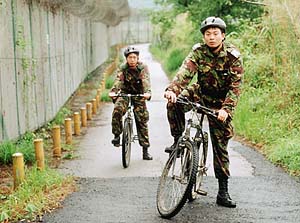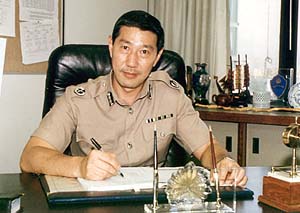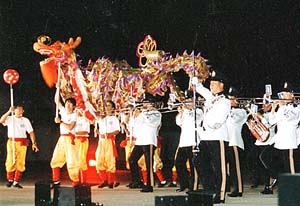



















Amalgamation of the Field Patrol Detachment with Border District | ||

Along the borderline: Field Patrol Detachment officers survey the border fence |
¡@A review begun in 1996 of anti-illegal immigration policing of the land border has identified a number of areas where improvements can be achieved through changes to the existing FPD, its deployment and command and control. These improvements can be achieved through the amalgamation of the FPD with Border District. | |
|
¡@As a result, the Commissioner of Police has agreed to a trial amalgamation of FPD with Border District - which will be done in phases starting next month - on 22 December. ¡@It's an idea whose time has come. ¡@At present each PTU Company undergoes three months training before undertaking a four-month attachment to the border as the Field Patrol Detachment. For the first three months of the FPD attachment the company is deployed in one of three border sectors, while the final month is spent as the QRF. On completion of the FPD attachment the company returns to the parent police region for a five-month tour before disbanding. This requires the Force to produce 13 PTU companies each year. ¡@Said Spencer Foo, ACP OPS: "Although this deployment has worked well, we have gained a great deal of experience since taking back the border. The amalgamation aims to build on this, achieve better co-operation and address the matter of overlapping command structures. We also benefit by reducing staff turn-over and save on training." ¡@The amalgamation will see PTU no longer performing FPD duties. What will happen is the PTU manpower held for FPD will be deployed as part of the present Border District. Each of the three Border divisions (at Man Kam To, Sha Tau Kok and Lok Ma Chau Sectors) will absorb one PTU company's worth of personnel. Meanwhile, a three platoon QRF will be retained in a task-force role, with a fourth platoon re-deployed to Yuen Long District to conduct anti-II duties in the Tsim Bei Tsui area as is the current practice. ¡@FPD training is currently provided as part of the PTU course. With FPD becoming part of Border District, the training will be provided in-house - by Border District. ¡@"This will lead to a reduction of the number of PTU Companies required to be trained from 13 to eight per annum, thereby reducing repeat attendance at PTU and ending duplicated training," explained ACP OPS Foo. ¡@"In the future, training at PTU will continue to be 12 weeks. As PTU companies are no longer required on the border this enables the regional attachment to be extended from the present 20 weeks to 30. A parallel study is currently underway to determine the most appropriate roles for Regional Companies, EUs and Task Forces to optimise the effectiveness of their respective deployments." ¡@The new combining of FPD with Border District will introduce a tenure whereby officers will work for 20 months on the amalgamated FPD (currently, with PTU they do four months on the border). At present Border District has an establishment of 678. Following amalgamation, this will rise to 1,205. There will be no reduction in police coverage along the border. ¡@In fact, it will only get better. The changes see enhanced command structure at the border, continuity of postings and more flexible, co-ordinated and effective deployment of resources within the District. ¡@"Twenty months is a good time frame," said Border District Commander Tommy Tse. "It allows for personnel to understand the nature of the border, their duties, the equipment, the residents in the area, etc. People build up on knowledge and experience acquired. In the past, officers were only here for a few months, then they'd leave. Co-ordination with border divisional duties performing anti-II work in the sectors was hampered by the frequent turnover of the FPD personnel. The continuity factor is another bonus point for the amalgamation." ¡@"Also, when the Force resumed border duties from the military in 1990, the FPD initially adopted many of their tactics. These have since evolved although it is recognised that our officers have different skills which the amalgamation aims to bring out. We have gained a lot of experience and we need to build upon that," said ACP OPS Spencer Foo. "Our officers speak the language of the people they are dealing with and can garner useful intelligence from the villagers in the area. Also our liaison with the other side is much better. That allows us to develop intelligence and communicate with them to make sure deployments are mirrored and we are getting a co-ordinated response. The amalgamation is the process of building on that." ¡@The rationale behind the combining of FPD with Border District not only seeks to build on the experience gained by FPD in recent years, it also provides the opportunity to enhance working conditions. ¡@"With the progressive changes, recruits coming to the new FPD don't have to be here for three or four years," said DC Border Tommy Tse. "Officers can expect to serve in Border District no more than 18 to 24 months, with a 12-month tenure in QRF. And all will work a 5-day, 48-hour week." ¡@At present the FPD is accommodated outside the border area at Queen's Hill Camp. Personnel of the new FPD will be barracked at the border, which will cut down on travelling time. "While temporary accommodation is provided in each sector, we're planning new purpose-built divisional stations in the border area which will accommodate the FPD and the regular duties together in one station. There will eventually be one centralised control room overseeing the whole border at Border District Headquarters." ¡@These are certainly challenging, fast-moving times for the Force, what with a new division preparing to become fully operational after the move from Kai Tak to the new airport at Chek Lap Kok - and now the amalgamation of FPD with Border District. ¡@From his perspective DC Border District Tommy Tse sees the transition as an opportunity for immense job satisfaction for officers who want to serve on the border - not to mention the beneficial effects of fresh air, which in many cases may be just a memory to a lot of officers serving elsewhere. ¡@"Serving in Border District has never been more rewarding," he said. "For officers in polluted areas, a two-year attachment at the border will not only be good for their health - but also their career. They will be doing the same important duties as the former FPD, but enhanced by new equipment which includes an updated fence detection system, under vehicle surveillance technology which allows officers to view monitors when checking cross-border traffic, etc. " ¡@Today Border District has daily communication with the other side through the Border-Liaison channel. Working in such close proximity to the Force's cross-border counterparts adds a dimension to the job that is unavailable in almost all other formations. | ||
|
¡@"We also have a dedicated catering staff who prepare excellent meals and there's ample sports and leisure opportunities," adds ADC OPS Border District, Evelyn Lam. "Which is not to say Border District isn't stressful or challenging. Officers get promoted and recognition for their work. It's just different than work in Mong Kok, say." ¡@"Even though we are a part of China, the border remains a very important aspect of policing in Hong Kong in terms of maintaining stability and confidence," said SSP OPS Border District Les Burton. ¡@"That makes the job very important. Because if there is a major influx of IIs - that will undoubtedly economically and socially destabilise the HKSAR. So we must remain ever vigilant." ¡@Controlled by a steering group headed by Director of Operations, and implemented by a team headed by DRC NTN, the amalgamation of FPD with Border District will take 44 weeks to achieve starting on 22 December with the QRF. ¡@Whereas previously a border company coming to its three-month duty's end would then move to QRF for one month. That company will now go straight to a region. Border District will then take an establishment of a disbanding company and form the new QRF with one platoon going to Yuen Long as well. ¡@Man Kam To sector will be amalgamated on 16 March 98. Then, Sha Tau Kok on 6 July 98, and Lok Ma Chau on 26 October 98. |

ACP OPS Spenser Foo: "This amalgamation will not cause any reduction in manpower for anti-II duties on the border. We will provide to Border District the same number of personnel as are now being used for Field Patrol Detachment"
| |
|
a sight to behold | |
 Hong Kong Police Silver Band plays along with the colourful machinations of the Junior Police Call's dragon |
¡@A celebration of the professionalism of the Hong Kong Police and the pride they take in serving the people of Hong Kong, spectators were thrilled by displays performed by serving officers, enchanted by the music of police bands from Hong Kong and Singapore, and amused at the antics of the Junior Police Call's dragon. |
|
¡@Highlights of the show included a resplendent opening fanfare presenting "Asia's Finest", along with brilliant musical pageantry of special guests, the renowned Singapore Police Force Band, and the precision of the Police Training School Drill Team's silent drill. ¡@Not to be outdone, the Police tactical Unit and the Special Duty Unit put on exciting operational scenarios amidst smoke bombs, simulated fire and swarms of "angry protestors". ¡@The effort and care that went into the performances is a reflection of the Force's wholehearted commitment to ensuring that Hong Kong remains one of the safest and most stable societies in the world. | |

